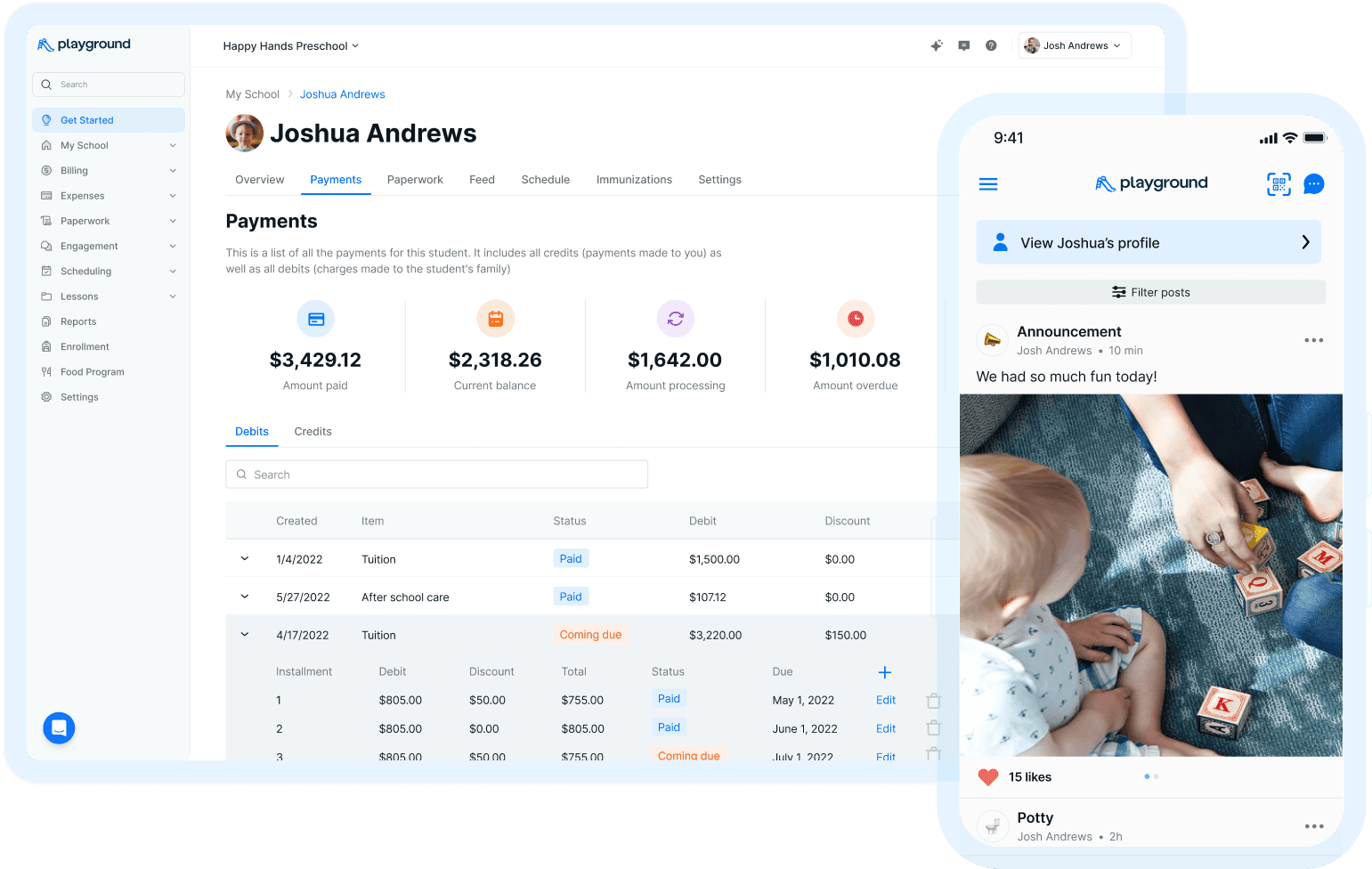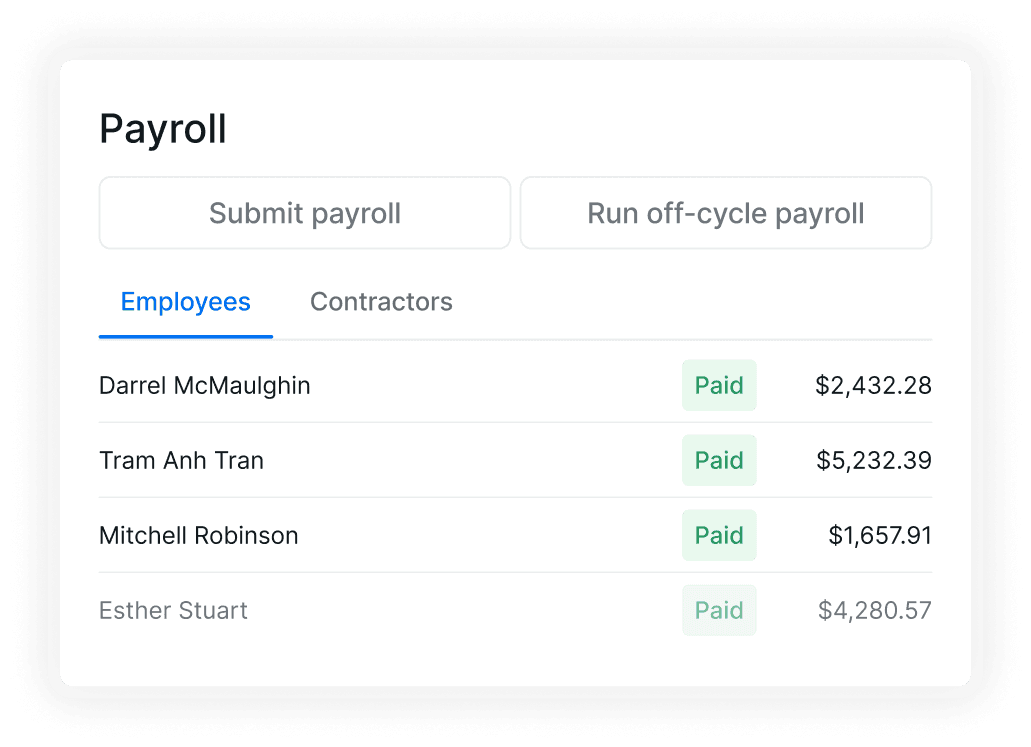Opening and operating a childcare business is a rewarding career path for many—but knowing how to run a daycare successfully requires a strong business plan. After locking down a location, a business plan for a childcare center is the second most important step in outlining what services you’ll offer, any financial goals you have, and other strategic steps for getting started. Whether you’re launching a family child care center or a multi-site chain, the right plan should cover everything from securing funding to attracting families.
A business plan is not just a formality, it’s a strategic roadmap that sets a strong foundation for a thriving business. With the right processes in place, keep growth at the center of your business while you deliver the best level of childcare.
So, you want to open a daycare business and you’re ready to put together a plan. To streamline the process, let’s break down your business plan into the 3 following focus areas:
Demographics and choosing a location
Financial plan and objectives
Daily operations
Getting started
Before you start putting the above three components together, your business plan should set the stage with an executive summary. An executive summary is a concise overview of your childcare business, which highlights your mission, goals, and unique value proposition. It directly addresses the central question: why should families choose your childcare center? The executive summary should clearly present what sets your business apart and explain the key reasons why parents should select your services. Ensure it’s compelling, clear, and aligned with the needs of the families you aim to serve in your area.
Demographics and choosing a location
Parents are going to select the best child care center that offers affordability and caters to their child’s unique needs, so it’s crucial to understand how you fit into the childcare landscape in which you’ll operate. This is your chance to pinpoint any gaps that exist and communicate how your center can fill those gaps with the services you offer. Ask yourself:
Who do you intend to serve? Are you catering to working parents?
Are there enough families in your desired area to sustain the business?
What’s the average income in your area? How will this influence tuition?
Is the area experiencing growth? Are younger families around?
With this research under your belt, you can start thinking about where you’d like to set up shop. Selecting the right location for a childcare center is a critical step, and will have a direct impact on your future success and enrollment rates. Consider the following:
Proximity to families. Setting up your center near large employers or business districts will attract working parents. Similarly, dense residential areas will attract younger families. You might also consider a location close to major transport hubs for ease-of-access.
Competition. Considering an area that is underserved or has more demand than there is care will likely contribute to your overall growth. Find out how many similar businesses exist in your desired location and the capacity of each. Do you offer something these programs don’t? Whether it’s extended hours or a bilingual offering, think about your differentiators and have them stand out.
Building size. Don’t just think of immediate needs, is the space you’re looking for able to accommodate future growth and in turn, more students? Does the building offer sufficient space for play areas and nap areas?
Area safety and accessibility. Safety is the utmost #1 priority for parents who are leaving their children in your care—ensure the location you pick is safe, secure, and accessible.
Nearby amenities. Nearby amenities can add value to your childcare business at no expense. Parks and libraries offer an incentive for parents and an opportunity for you to expand your teaching space.
Financial plan and objectives
Investors and business partners will look to answer one question when reviewing your plan: how will this business make money? This is where detail matters. You’ll need to outline the following in your plan: startup costs—which may include facility rent, equipment and technology, renovations—monthly expenses like staff salaries, projected monthly revenue from tuition, and a profit-to-loss projection.
Start-up costs
Create a detailed list of all the essential items required to successfully operate your center. While the following list isn’t exhaustive, it will help you get started and may assist in identifying which items are crucial and which can be deferred (at least initially).
The free, downloadable excel template below covers a 12-month period. It outlines your start-up costs for the first year but also helps you forecast monthly expenditures. This is important because you should aim to have six months’ worth of operating cash on hand, as it’s unlikely your enrollment will reach full capacity instantly. If you’re confident in starting at half capacity, three months of cash reserves might suffice. Be sure to include all start-up costs in your first-month projections and stick to your budget as you become more familiar with your income and expenses.
Opening and operating a childcare business is a rewarding career path for many—but knowing how to run a daycare successfully requires a strong business plan. After locking down a location, a business plan for a childcare center is the second most important step in outlining what services you’ll offer, any financial goals you have, and other strategic steps for getting started. Whether you’re launching a family child care center or a multi-site chain, the right plan should cover everything from securing funding to attracting families.
A business plan is not just a formality, it’s a strategic roadmap that sets a strong foundation for a thriving business. With the right processes in place, keep growth at the center of your business while you deliver the best level of childcare.
So, you want to open a daycare business and you’re ready to put together a plan. To streamline the process, let’s break down your business plan into the 3 following focus areas:
Demographics and choosing a location
Financial plan and objectives
Daily operations
Getting started
Before you start putting the above three components together, your business plan should set the stage with an executive summary. An executive summary is a concise overview of your childcare business, which highlights your mission, goals, and unique value proposition. It directly addresses the central question: why should families choose your childcare center? The executive summary should clearly present what sets your business apart and explain the key reasons why parents should select your services. Ensure it’s compelling, clear, and aligned with the needs of the families you aim to serve in your area.
Demographics and choosing a location
Parents are going to select the best child care center that offers affordability and caters to their child’s unique needs, so it’s crucial to understand how you fit into the childcare landscape in which you’ll operate. This is your chance to pinpoint any gaps that exist and communicate how your center can fill those gaps with the services you offer. Ask yourself:
Who do you intend to serve? Are you catering to working parents?
Are there enough families in your desired area to sustain the business?
What’s the average income in your area? How will this influence tuition?
Is the area experiencing growth? Are younger families around?
With this research under your belt, you can start thinking about where you’d like to set up shop. Selecting the right location for a childcare center is a critical step, and will have a direct impact on your future success and enrollment rates. Consider the following:
Proximity to families. Setting up your center near large employers or business districts will attract working parents. Similarly, dense residential areas will attract younger families. You might also consider a location close to major transport hubs for ease-of-access.
Competition. Considering an area that is underserved or has more demand than there is care will likely contribute to your overall growth. Find out how many similar businesses exist in your desired location and the capacity of each. Do you offer something these programs don’t? Whether it’s extended hours or a bilingual offering, think about your differentiators and have them stand out.
Building size. Don’t just think of immediate needs, is the space you’re looking for able to accommodate future growth and in turn, more students? Does the building offer sufficient space for play areas and nap areas?
Area safety and accessibility. Safety is the utmost #1 priority for parents who are leaving their children in your care—ensure the location you pick is safe, secure, and accessible.
Nearby amenities. Nearby amenities can add value to your childcare business at no expense. Parks and libraries offer an incentive for parents and an opportunity for you to expand your teaching space.
Financial plan and objectives
Investors and business partners will look to answer one question when reviewing your plan: how will this business make money? This is where detail matters. You’ll need to outline the following in your plan: startup costs—which may include facility rent, equipment and technology, renovations—monthly expenses like staff salaries, projected monthly revenue from tuition, and a profit-to-loss projection.
Start-up costs
Create a detailed list of all the essential items required to successfully operate your center. While the following list isn’t exhaustive, it will help you get started and may assist in identifying which items are crucial and which can be deferred (at least initially).
The free, downloadable excel template below covers a 12-month period. It outlines your start-up costs for the first year but also helps you forecast monthly expenditures. This is important because you should aim to have six months’ worth of operating cash on hand, as it’s unlikely your enrollment will reach full capacity instantly. If you’re confident in starting at half capacity, three months of cash reserves might suffice. Be sure to include all start-up costs in your first-month projections and stick to your budget as you become more familiar with your income and expenses.
Opening and operating a childcare business is a rewarding career path for many—but knowing how to run a daycare successfully requires a strong business plan. After locking down a location, a business plan for a childcare center is the second most important step in outlining what services you’ll offer, any financial goals you have, and other strategic steps for getting started. Whether you’re launching a family child care center or a multi-site chain, the right plan should cover everything from securing funding to attracting families.
A business plan is not just a formality, it’s a strategic roadmap that sets a strong foundation for a thriving business. With the right processes in place, keep growth at the center of your business while you deliver the best level of childcare.
So, you want to open a daycare business and you’re ready to put together a plan. To streamline the process, let’s break down your business plan into the 3 following focus areas:
Demographics and choosing a location
Financial plan and objectives
Daily operations
Getting started
Before you start putting the above three components together, your business plan should set the stage with an executive summary. An executive summary is a concise overview of your childcare business, which highlights your mission, goals, and unique value proposition. It directly addresses the central question: why should families choose your childcare center? The executive summary should clearly present what sets your business apart and explain the key reasons why parents should select your services. Ensure it’s compelling, clear, and aligned with the needs of the families you aim to serve in your area.
Demographics and choosing a location
Parents are going to select the best child care center that offers affordability and caters to their child’s unique needs, so it’s crucial to understand how you fit into the childcare landscape in which you’ll operate. This is your chance to pinpoint any gaps that exist and communicate how your center can fill those gaps with the services you offer. Ask yourself:
Who do you intend to serve? Are you catering to working parents?
Are there enough families in your desired area to sustain the business?
What’s the average income in your area? How will this influence tuition?
Is the area experiencing growth? Are younger families around?
With this research under your belt, you can start thinking about where you’d like to set up shop. Selecting the right location for a childcare center is a critical step, and will have a direct impact on your future success and enrollment rates. Consider the following:
Proximity to families. Setting up your center near large employers or business districts will attract working parents. Similarly, dense residential areas will attract younger families. You might also consider a location close to major transport hubs for ease-of-access.
Competition. Considering an area that is underserved or has more demand than there is care will likely contribute to your overall growth. Find out how many similar businesses exist in your desired location and the capacity of each. Do you offer something these programs don’t? Whether it’s extended hours or a bilingual offering, think about your differentiators and have them stand out.
Building size. Don’t just think of immediate needs, is the space you’re looking for able to accommodate future growth and in turn, more students? Does the building offer sufficient space for play areas and nap areas?
Area safety and accessibility. Safety is the utmost #1 priority for parents who are leaving their children in your care—ensure the location you pick is safe, secure, and accessible.
Nearby amenities. Nearby amenities can add value to your childcare business at no expense. Parks and libraries offer an incentive for parents and an opportunity for you to expand your teaching space.
Financial plan and objectives
Investors and business partners will look to answer one question when reviewing your plan: how will this business make money? This is where detail matters. You’ll need to outline the following in your plan: startup costs—which may include facility rent, equipment and technology, renovations—monthly expenses like staff salaries, projected monthly revenue from tuition, and a profit-to-loss projection.
Start-up costs
Create a detailed list of all the essential items required to successfully operate your center. While the following list isn’t exhaustive, it will help you get started and may assist in identifying which items are crucial and which can be deferred (at least initially).
The free, downloadable excel template below covers a 12-month period. It outlines your start-up costs for the first year but also helps you forecast monthly expenditures. This is important because you should aim to have six months’ worth of operating cash on hand, as it’s unlikely your enrollment will reach full capacity instantly. If you’re confident in starting at half capacity, three months of cash reserves might suffice. Be sure to include all start-up costs in your first-month projections and stick to your budget as you become more familiar with your income and expenses.
Daily operations
Your plan is going to dictate how your business runs on a daily basis. Describe how your daycare program will meet the daily needs of different family units while enriching the learning experiences of every child. Consider the following:
Handbook
You will need to create handbooks to easily reference policies, procedures, and rules. One handbook may be tailored to staff, and another to parents. Each will have its own unique content, but tie back to your overall mission and goals.
Curriculum
Children are on a constant path of development, and your curriculum must reflect each stage of this development. Your operational plan should include:
The framework or any early education philosophies shaping your approach (e.g. Montessori, Reggio Emilia)
How your curriculum relates to cognitive, social, and emotional growth for children
What specialized topics and activities children will be able to access (e.g. STEM activities, creative arts)
Hours and flexibility
Flexibility is key for parents in today’s working environment–especially as many navigate returning to the office. Lay out details for how you’ll accommodate the families who require flexibility, whether that’s evening care or drop-in services.
Enrichment programs and extracurriculars
Highlight the specific activities you offer that help you stand out from other childcare providers in the area. Whether that’s music, art, sports, or language immersion; explain how these activities contribute to overall child development.
Inclusive care
Some students may exhibit physical or emotional challenges when it comes to learning. In your plan, explain how you plan to support these students and what resources exist for teachers to tap into for supporting these children. Specialized services and dedicated special needs teachers can help your center stand out and show an ongoing commitment to good childcare for all.
Parent engagement
Maintaining transparent communication between parents and staff at your center helps foster a culture of trust—an essential aspect of running a daycare business. Consider how you’ll engage with parents, like through a childcare management app. Parents value the opportunity to stay involved in their child’s care, so implementing a thoughtful communication strategy will enhance the appeal of your center.
Capacity
Based on the square footage of your center and outdoor space, many states limit the number of children you can enroll. As such, you will need to determine capacity and how to divide those numbers between age groups. Remember too, parents are looking at child:teacher ratios as one of the benchmarks of a quality program.
Staffing requirements
Meeting legal staff requirements is one basic step to take, but showing a dedicated, ongoing commitment to hiring, training, and retaining the best staff can further contribute to success. To maintain a top-tier level of education at your center, explain how you plan to attract the best educators, and keep them on.
When staff feel valued and see that you’re investing resources into their ongoing development and growth, they’re more likely to feel valued at your organization, and that will show in their performance. Whether the question is how’ll you recruit or how you’ll promote retention, your staffing plan is vital.
Licensing and regulatory compliance
When caring for children, compliance is critical. There are legal steps and requirements your business must follow in line with local, state, and federal regulations. This means obtaining the right certifications and licenses, ensuring your center is safe and secure, and emergency plans are in place. Childcare laws are stringent and always evolving—be sure your business is equipped to respond to these changes.
Marketing strategy
Reaching families to promote your daycare business might seem easy with social media, but an increasing number of touchpoints means it’s harder to build connections. Don’t underestimate the power of a solid marketing strategy in boosting enrollment for your program.
Outline a tailored strategy that suits your community and the families you wish to target—think about how you’ll use social media, partner with local businesses, host events, or build a website. Parents want to know what makes your center the right choice, put the time and effort into conveying what makes you special.
Vision and long term growth
While step one is getting doors open, don’t discount the future state of your business. What’s your long-term strategy? How will you adapt to growth should demand increase? While facility upgrades and capacity increases may not be on your radar right now, a good business plan takes these future events into consideration.
Creating a solid business plan for a childcare center involves more than just outlining what services you’ll offer and any financial projections—it’s about setting a strategic foundation for long-term growth.Remember, your plan should not only highlight the uniqueness of your childcare services but also focus on day-to-day operations to forecasting financial stability. With a well-thought-out business plan, you’ll be well-equipped to navigate the challenges of running a daycare while creating a nurturing environment for children.






